Core Instructional Priorities of Deeper Learning in SFUSD
Link to this section
Inquiry Pedagogy
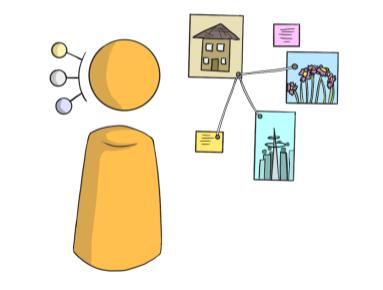 Inquiry Pedagogy
Inquiry Pedagogy
The thinking and questioning of students is the focal point. Students build connections to prior learning and experiences, and are independent learners who make their thinking visible.
Equity Frame
- White supremacy culture is furthered by worship of the written word and objectivity - the belief that there is only one right way to do things (learn skills, content to digest, etc.) and that content can be objective.
- Culturally responsive teaching values and connects learning to students’ communities and everyday lives, and provides authentic opportunities to process understanding.
Methodologies of Inquiry-based Learning
Project-Based Learning
PBL Works offers one of the most comprehensive set of project-based learning resources available, including their framework for project design that includes the following seven elements of gold-standard project-based learning.
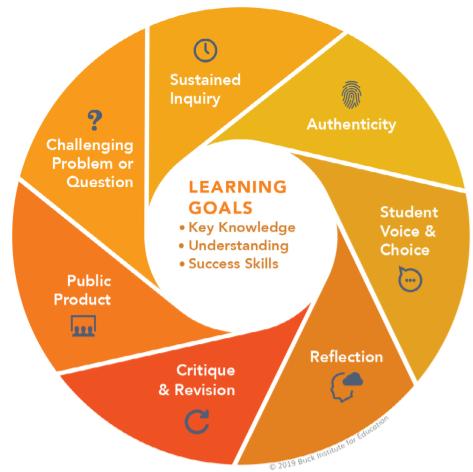
In project-based learning, students approach learning through exploration of real-world challenges and problems. The project is framed by a meaningful problem to be solved or a question to answer, at the appropriate level of challenge. Starting with a challenging problem or question is the first step towards launching a project rooted in sustained inquiry. The video below demonstrates how to design a project centered around solving a meaningful problem or answering a driving question.
Visit PBL Works Project Design Page to view videos of sample projects leveraging sustained inquiry and other project design elements, as well as additional resources and strategies for enhancing sustained inquiry. Two resources you will find there include:
- Resource List - Sustained Inquiry in PBL
- How We Use “Need to Know” Questions to Guide Sustained Inquiry
Making Thinking Visible
Students use a series of routines to integrate the development of metacognitive thinking with content learning across subject matters.
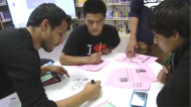 Writing on Tables - Visual Thinking Strategy
Writing on Tables - Visual Thinking Strategy
Chris Maldonado turned his classroom tables into visual thinking surfaces by sanding and painting them with whiteboard paint, allowing students to communicate through visuals.
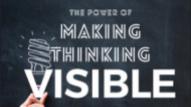 YouTube Chanel
YouTube Chanel
The Making Things Visible YouTube Chanel offers the opportunity to see videos of a wide variety of visible thinking strategies in action!
Tip: Use thinking routines to support students in intentionally practicing different kinds of thinking, and making that thinking visible. Here are two examples of assignments designed in SeeSaw using thinking routines. Example 1 and Example 2. Here is a small bank of thinking routines and how you might use them in a digital context.
Experiential Learning
Youth Participatory Action Research (YPAR)
"YPAR (Youth-led Participatory Action Research) is an innovative approach to positive youth and community development based in social justice principles in which young people are trained to conduct systematic research to improve their lives, their communities, and the institutions intended to serve them." Visit YPAR Hub to learn more!
Reading Like a Historian
The Reading Like a Historian curriculum engages students in historical inquiry, teaching students how to investigate historical questions by employing reading strategies such as sourcing, contextualizing, corroborating, and close reading. Visit the Stanford History Education Group page to learn more.
Experiential Learning Cycle
The experiential learning cycle includes four stages- experiencing, reflecting, thinking, and acting.
Workshop Model
The classroom is set up as a lab environment where students approach learning through a constructivism - utilizing instruction and feedback for project/task design, development and execution.
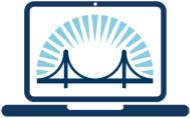 Technology that Enables Inquiry
Technology that Enables Inquiry
The following digital learning competencies from SFUSD's Digital Learning Scope & Sequence support an inquiry-based pedagogy.
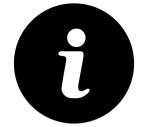 News and Media Literacy
News and Media Literacy
Identify credible & trustworthy sources of information, consider legal and ethical aspects of using the creative work of others, and apply this knowledge as they create & curate digital content.
 Locate Information
Locate Information
Plan and employ effective research strategies such as using keywords, phrases, filters, operators, & modifiers in search engines, library catalogues, and other databases to locate articles, images, charts, graphs, data, and primary sources. (Google Chrome, Britannica Online, SIRS Issue Researcher, Gale Student Resources, Newsela)
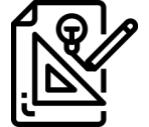 Design Process
Design Process
Know and use a deliberate design process for generating ideas, testing theories, creating innovative artifacts or solving authentic problems. (Google Jamboard & Padlet for brainstorming)
Collaboration
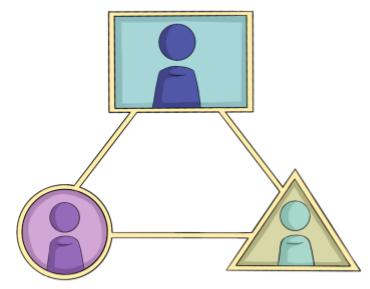 Collaboration
Collaboration
Students interact in meaningful ways through conversation, or participation in collaborative structures. The educator serves as facilitator and a collectivist or communal approach is used.
Equity Frame
White supremacy culture is furthered by individualism and power hoarding - a focus on competition with individual winners and losers.
Culturally responsive teaching builds classroom culture that is communal, where interdependence is centered.
Methodologies
Complex Instruction
Students work in linguistically, racially, socially heterogeneous groups to learn and problem solve together. Students see each member as capable, and therefore as resources for each other. There is equal-status participation in thinking and learning.
Group Roles
![]() Collaborative groups benefit from clear group roles for their members. Here are some sample role cards that can be used with different grades.
Collaborative groups benefit from clear group roles for their members. Here are some sample role cards that can be used with different grades.
Math Talks
 Math Talks are a powerful teaching tool. They are a teacher-led student-centered technique for building math thinking and discourse.
Math Talks are a powerful teaching tool. They are a teacher-led student-centered technique for building math thinking and discourse.
Authentic Academic Conversation
Give One, Get One
See Give One, Get One- a structure for accountable talk in the context of academic discourse. Observe teacher moves for strategic grouping, accountable talk, and setting up students for a successful share-out.
Structured Language Protocol (Board Games)
Students engage in accountable language practice through a board game. Ariana puts structures in place for students to practice language collaboratively and hold each other accountable.
Positive Interdependence
Students recognize that their individual success is linked to the success of every other member of their group/class, and the structure of the task requires unique contributions from each student.
Part of Edutopia's 5 Keys to Rigorous PBL video series, this video focuses on how to organize your learning environment to support student collaboration.
Additional Resources
- A resource bank of strategies for supporting group work
- A spectrum of procedures and protocols
- Tools for supporting collaboration - NTN Team Collaboration Checklist
 Technology that Enables Collaboration
Technology that Enables Collaboration
The following digital learning competencies from SFUSD's Digital Learning Scope & Sequence support an inquiry-based pedagogy.
 Feedback
Feedback
Use collaborative tools to share drafts of their work in order to give & receive feedback from peers, teachers, and other audiences beyond the classroom. (Google Docs, Slides, & Classroom)
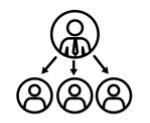 Project Management
Project Management
Leverage collaborative technologies to contribute constructively to project teams, assuming various roles and responsibilities to work effectively toward a common goal. (Google Keep, Sheets, Docs, Slides, Drawing, Forms, Calendar, Classroom)
 Problem Solving
Problem Solving
Explore local and global issues and use collaborative technologies to work with others to investigate solutions. (KQED Learn, Google Suite)
Equitable Access & Demand
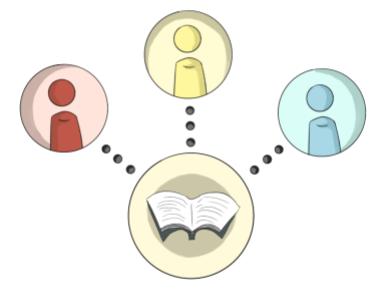 Equitable Access & Demand
Equitable Access & Demand
Curricula is designed and instruction is delivered to ensure access for all and cognitive demand for “each and every” student, supporting independence, not dependence.
Equity Frame
White supremacy culture is furthered by perfectionism and either/or thinking - simplifying complex work, assuming deficit, and with little room for personalization.
Culturally responsive teaching provides appropriate challenges and supports students to take greater ownership of their learning.
Methodologies
Language Development
Educators use linguistic scaffolds to provide access to rigorous content and idea building.
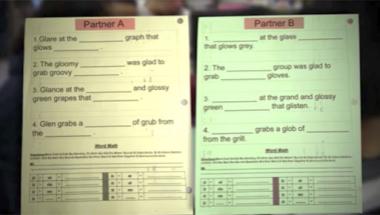 Split Dication
Split Dication
Working in pairs, students read a shared text to each other, but each version of the text is missing specific words. Students listen to each other and fill in missing words on their own papers. Split dictation requires students to listen very carefully and pronounce the words as best they can. Watch this video of split dictation in action from the teaching channel, and edited video of the full lesson.
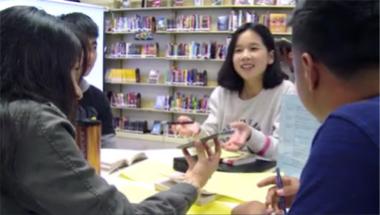 Literature Circles
Literature Circles
In Kyle Halle-Erby's senior seminar class at SF International, newcomer English Language Learners engage in literature circles once a week. Students first work in heterogeneous groups to read a chapter and complete an individual response. Students then prepare for the literature circle discussion by moving to role-alike groups. Finally, students move back to their original groups for the discussion.Watch this video of literature circles in action from the teaching channel.
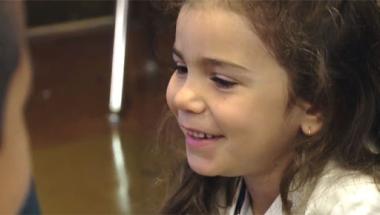 Second Set Partners - A Turn & Talk Strategy
Second Set Partners - A Turn & Talk Strategy
Second Set Partners is a turn and talk strategy meant to improve students' listening and speaking skills. First, students talk with a rug partner. Next, they switch partners and tell the second partner what the first partner said. Watch this video of second set partners in action from the teaching channel. Watch an edited version of the full lesson to see the strategy in context.
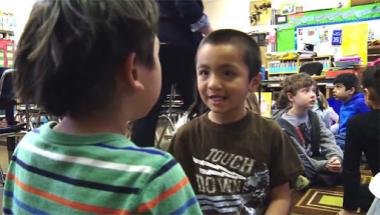 Warming Up with Rug Partners
Warming Up with Rug Partners
Elizabeth Iwaszewics uses this strategy as a warm opener to help students transition from recess or lunch and to the classroom. Watch this video of literature circles in action from the teaching channel. Watch the and edited version of the full lesson to view the strategy in context.
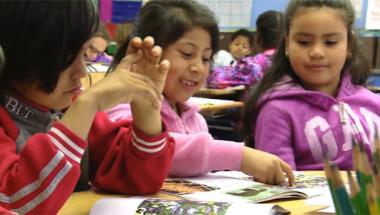 Say it with Your Hands
Say it with Your Hands
In this video, Anna Dearlove explains how she uses hand gestures to clarify language and encourages students to use gestures to explain their own thinking. Watch this video of literature circles in action from the teaching channel.
 Technology that Enables Equitable Access & Demand
Technology that Enables Equitable Access & Demand
The following digital learning competencies from SFUSD's Digital Learning Scope & Sequence support an inquiry-based pedagogy.
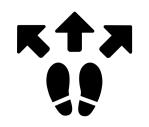 Choice & Voice
Choice & Voice
Students choose the appropriate platforms and tools for meeting the desired objectives of their creation or communication and publish or present content that customizes the message and medium for their intended audiences.
 Media Balance & Well Being
Media Balance & Well Being
Explore their own digital lives and reflect on the positive and negative impact digital media have on themselves and on society.
Assessment for Learning
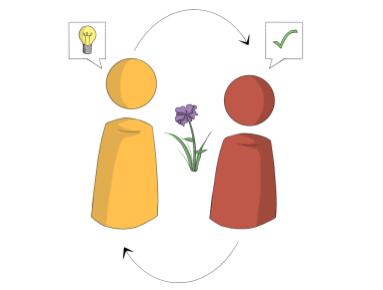 Assessment for Learning
Assessment for Learning
Students are provided with time, space and support to set goals, assess learning, track progress and present their growth. Students are seen as co-designers of their assessment, owning and sharing their learning.
Equity Frame
White supremacy culture is furthered by paternalism - educators making decisions for students and families without their input, and quantity over quality - where process is not valued. personalization.
Culturally responsive teaching reimagines the student and educator relationship as a partnership where student voice, agency and reflection is centered.
Methodologies
Deeper Learning focuses on teaching students how to learn. In order to best gauge how students are acquiring knowledge they'll need to be assessed in ways that may seem different than standard practice. Here are some assessment for learning best practices.
Portfolios
A portfolio is a purposeful collection of students’ individual work that exhibits their efforts, progress, and achievements over time against a set of clearly defined outcomes. In a portfolio defense, the student publicly engages in a prepared, reflective discussion about their learning, including a self-assessment of growth and their next steps.
Portfolios in Action:
From a series of videos filmed by the Teaching Channel at an Envision School in San Francisco, in 2013. On the transformative core elements of an authentic performance assessment system, and portfolio defense. Highlighting Yvonne Armenta, high school graduate 2013, UC Berkeley graduate 2018.
Foundational Reading:
Preparing Students for Portfolio Defense to Build Agency: At Envision schools, strong relationships, a college going culture, and project-based learning prepare students for their culminating portfolio defense, which builds their agency.
Additional Portfolio Resources:
- SFUSD 5th Grade Portfolio Toolkit (Adaptable K-8)
- Reflection on Portfolio Assessment at San Francisco International High School
- KQED Teach offers a free 6 hour online course for teachers about leveraging digital portfolios for assessment.
Capstones
A capstone is a culminating project, performance, or structured experience that demonstrates learning of pre-determined outcomes and act as closure to a long-term arc of learning. Often capstones include a significant research and writing component, and conclude with public demonstrations of learning in front of an audience, and successful completion of capstones are often tied to promotion or graduation.
Capstone in Action:
Sudents and teachers discuss Capstone projects in Oakland Unified School District, part of the video series Reflections on Oakland’s Graduate Capstone Project
Foundational Reading:
How Senior Capstone Projects Let Students Research and Present Their Passions - Lisa Vardi - Jan 30, 2018 - Ed Surge
Additional Resources from SFUSD schools:
- Reflection on the Capstone project at John O'Connell High School
- John O'Connell Public Service Pathway Capstone Overview
- John O'Connell Capstone Presentation Rubric
- Reflection on the Capstone project at JJSE
Presentations of Learning
Presentations of learning are events that celebrate students’ learning and achievements by making them visible to the community. Whether it is getting student work on the walls, showcasing a class project, or hosting a whole-school exhibition with community members and experts, exhibitions put student work and voice at the center.
Foundational Reading:
Presentations of Learning in Action:
Kindergarteners as Experts from EL Education on Vimeo.
Students Share Work that Matters with an Authentic Audience from EL Education on Vimeo.
Agency, Choice, and Voice through Podcasting: In this video, students and staff from Hoover Middle School share their experience with student created podcasts as a way to amplify student voice, personalize learning through offering choice in process and product, and increase student agency through creativity and collaboration.
Additional Resources from SFUSD Schools:
- Reflection on Exhibitions of Learning at San Francisco Community School
- Reflection on Exhibitions of Learning at Independence High School
- Independence High School Exhibition of Learning Program
- Presentations of Learning at Independence High School
Additional Resources
Student-Led Conferences
Student-led Conferences are meetings between students, their families, and their teachers to share academic work and discuss progress. Though the format may vary, these conferences differ from traditional conferences in that they place students at the helm of teacher-supported discussions with parents about student progress and learning.
What is a Student-Led Conference?
- An opportunity for students to share with their families and teachers their work and their own reflections on their learning.
- A structured format that puts the student front and center of the process. Students truly lead the conference, but everyone involved actively participates.
Why have Student-Led Conferences?
- Student-led conferences help students cultivate ownership of their education and build a strong connection between home and school.
- The conference process helps students comprehend the importance and means of taking charge of their own learning.
When Should Student-Led Conferences be held?
- Schools that have adopted this model use it twice a year at the time when traditional family-teacher conferences are usually held.
- Opportunities for a separate time to meet with teachers if families would like to discuss their children’s progress with the teacher are also made available to families.
- Language from SFUSD's Overview of Family Teacher Conferencing Strategies
Foundational Reading:
Leaders of Their Own Learning: Chapter 5: Student-Led Conferences - EL Education
Student-Led Conferences in Action:
A student at SFUSD's Visitacion Valley Middle School shares his learning
Description of the power of SLCs for student empowerment & ownership
Additional Resources from SFUSD Schools:
- Reflection on SLCs at Roosevelt Middle School
- Google Slides template students can use to prepare for an SLC
- Middle School Lead Team SLC Starter Kit
Additional Resources
Formative Assessment
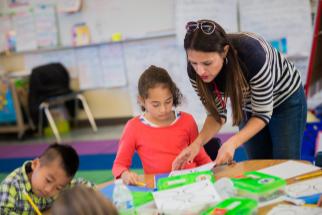 Formative Assessment is an ongoing assessment practice that regularly measures student learning in order to shape instruction. Teachers use a variety of formative assessment strategies to gather data on student learning in relation to targeted learning objectives, and intentionally take pedagogical action in response to that data.
Formative Assessment is an ongoing assessment practice that regularly measures student learning in order to shape instruction. Teachers use a variety of formative assessment strategies to gather data on student learning in relation to targeted learning objectives, and intentionally take pedagogical action in response to that data.
Foundational Reading:
What Are Formative Assessments and Why Should We Use Them? (Scholastic). Tips for using formative assessment to help you differentiate instruction and improve student achievement.
Performance Assessment:
Performance Assessments invite students to demonstrate standards proficiency through task-based application. These tasks offer opportunities for students to use higher-order thinking skills as they create a product or perform a task. Ideally, these tasks mirror the work of professionals, providing students opportunities to engage in authentic work.
Foundational Reading: Performance-Based Assessment: Reviewing the Basics
Additional Resources from SFUSD Schools:
Critique and Iteration:
Students revise projects/tasks through a study of exemplars and by engaging in a culture of critique with peers and educators. Feedback is reciprocal with a set of feedback norms, such as “be kind, specific and helpful. Students continually revise and reflect on coursework, tracking their progress on a given project/task towards mastery. The emphasis of coursework is on quality over quantity of work and building craftsmanship.
See Ron Berger from EL Education demonstrate the transformative power of models, critique, and descriptive feedback to improve student work.
Visit EL Education to learn more.
Kind, Specific, & Helpful Feedback Model
Additional Resources for Teachers
- The Bridge Between Today's Lesson and Tomorrow's
- Formative Assessment in Distance Learning - Edutopia
- Formative Assessment in Action - WestEd
Additional Resources for District Leaders and School Administrators
- Fundamental Insights about Formative Assessment
- An Integrated Approach to Defining a System-Level Theory of Action for Formative Assessment
- Design Principles for New Systems of Assessment
School-wide Rubrics
A school-wide rubric is an assessment tool that is commonly used to measure student learning across a school site, sometimes through different content areas and sometimes across grade levels as well. School-wide rubrics provide a platform for school site colleagues to collaborate around student learning goals, calibrate around quality student work, and provide students with more consistent expectations, language, and structures across classrooms, content areas, and grade levels.
Additional Assessment for Learning Resources
At the Assessment for Learning Project, five core shifts in perspective and relevant design principles drive our mission to redefine assessment.
CPAC seeks to advance the use of authentic approaches to assessment in which students are required to demonstrate applied knowledge of content and use of 21st century skills.
When Students Lead Their Learning - an article about students taking a lead role in understanding and communicating their progress through reflecting on their learning in front of parents and panels of experts.
 Technology that Enables Assessment for Learning
Technology that Enables Assessment for Learning
The following digital learning competencies from SFUSD's Digital Learning Scope & Sequence support assessment for learning methodologies.
 Digital Portfolios
Digital Portfolios
Use digital tools to document their process and contribute towards a digital portfolio that includes a curation of their best work and reflection on how that work contributes to their academic learning goals, personal interests, and career aspirations. (Seesaw - K-5, Showcase 6-12, New Google Sites - 6-12, Adobe Spark Pages 3-12)
 Prototype
Prototype
Develop, test and refine prototypes as part of a cyclical design process. (Google Forms to collect end-user feedback; Chrome canva to draw a prototype, 3D modeling software, etc)
 Presentations
Presentations
Individually and collaboratively publish presentations that include a combination of images, text, video, and audience interactivity in order to communicate ideas clearly and effectively. (Google Slides)
This page was last updated on June 28, 2022

